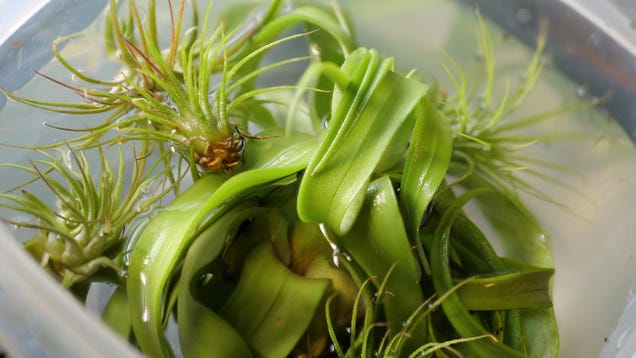Over my life, I’ve heard a million different recommendations about how to water plants, ranging from “once a week, weakly” to “water until it runs out the bottom” to my favorite, “water when things start to look sad.” I’ve spent the last month nervously plant-sitting fifty or so rare plants for a friend—a master gardener named Mo who works at the local nursery—and I was shook by her gardening advice, which I’ve now accepted as truth: you should drown your plants.
I had been watering both her menagerie and mine every few days, and Mo would swing by and re-water the plants, insisting I had not done enough. I trust her, but noted how I typically let the water run out the bottom. “How much more water does it need?” I asked.
Mo grabbed a five-gallon bucket, filled it with water, and then took the plant we’d just re-watered and dunked it into the bucket. She held it under the water as bubbles came up from the potted plant, and when they stopped, she took the plant out, gave it a little shake, and put it back on the ground.
“That’s how much.” she responded.
How to drown (submerge) your plants
For smaller or indoor plants, just fill a sink with water and make sure there’s enough water that the entire pot can sit underwater. Submerge your pots under the water, holding them down until the bubbles disappear.
For outdoor plants, grab a bucket for plants under 10L, and fill it up with water. For larger plants, plastic totes work really well to hold enough water.
Submerge your plants so the soil absorbs water
Soil can become hydrophobic—meaning that it’s not absorbing water—for a variety of reasons, but it’s usually from under watering. You can recognize it by water rolling off or through the soil rather than actually wetting it. You can solve it by submerging your plant, displacing the oxygen in the soil. That’s what Mo was looking for as the bubbles came up from her plant: oxygen leaving the soil, being displaced. Once the soil is no longer hydrophobic, it’ll take on water easier in the future.
Submerging plants can also solve some pest problems
It’s inevitable that you’ll have some pest problems in your potted plants. Inside, thrips are a notorious and contagious challenge; outside, you have pests like aphids. One solution that usually works is to simply drown them. This will only work if they’re soil bound, but the soil is where your larvae usually lives. You can certainly dunk the plant leaves as well, as this will dust them off and give them a good drink. It also drowns some pests on the leafy tops.
Between dunk sessions, be sure your plant has an opportunity to dry out, as continuous sopping-wet roots doesn’t work well for most plants. Obviously, drain them somewhere that can take the water, like a sink or patio. Your plants should also have good drainage in the pots themselves.

Leave a Reply
You must be logged in to post a comment.